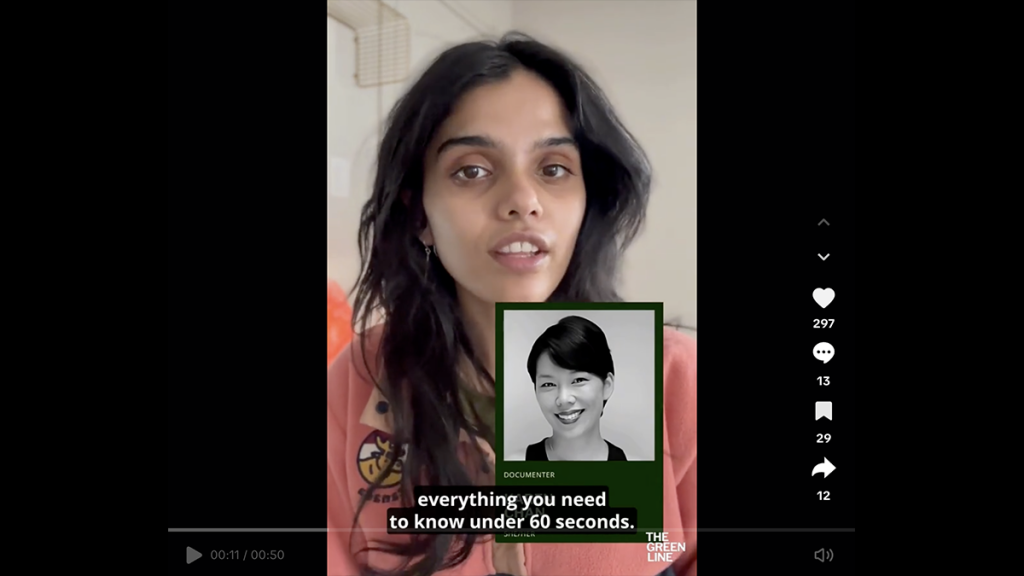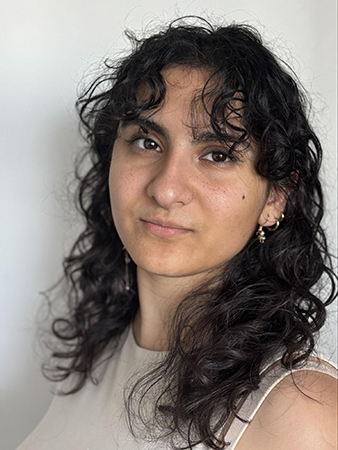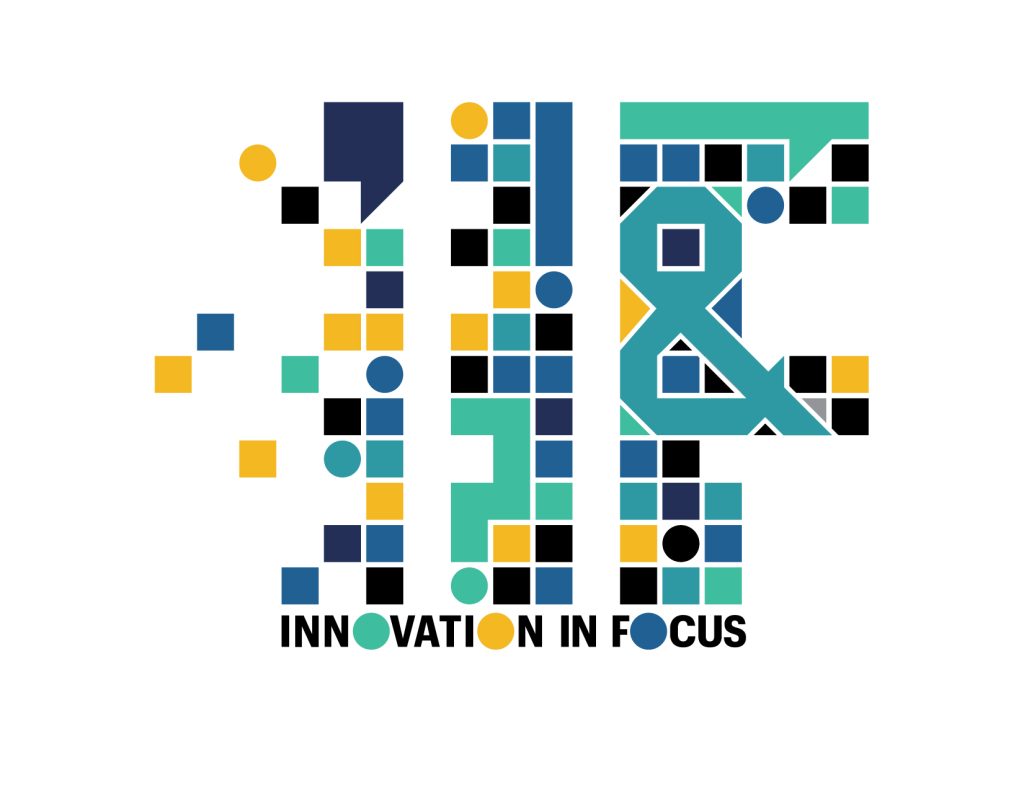
The Green Line uses TikTok to connect their audience with public meeting coverage from Documenters, who are paid and trained community members who record meeting notes.
Taking public meeting notes to TikTok — and making it actionable
How to experiment with video formats for the Documenters program

The Green Line focuses on highlighting actionable solutions to real issues that communities in Toronto care about. The newsroom is taking a similar approach to how they cover public meetings and civic information. While The Green Line has been working with Documenters — paid and trained community members who take notes in public meetings — since the fall, managing editor Yara El Murr said they are continuing to find new ways to make that information more accessible. Part of that strategy has been experimenting with short-form videos based on the Documenters’ notes.
Examples of The Green Line’s TikTok videos
- About the redevelopment of a community centre
- About a public meeting from a local land trust
- Data digging in response to popular concerns that came up during meetings
- This video inspired someone to attend a meeting
Lytle: How does The Green Line’s focus on action and solutions affect how you approach city government coverage?
El Murr: We want people to engage not just with the news that we deliver but with their communities and the world around them. And the Documenters program is part of that because it’s community members who are documenting these meetings. So already this is one step where people are getting more involved. The next step with that is, as they’re documenting, they’re also thinking about, “Okay, they’re talking about this big citywide policy. How does that affect me and my neighbors? What can we do about it?” One thing we almost always have at the end of any Documenters note or story we send is a call to action. For example, if there’s a development: If you have complaints or comments, here’s the city councillor you can email, or here’s the city planner taking feedback. Or another consultation is happening about this topic; here’s a survey you can fill out.
Lytle: Tell me more about your strategy to bring these Documenters notes to TikTok. How did that come about?
El Murr: If I’m being honest, it came from a bit of trial and error, but also because The Green Line is a very visual publication. And video is really in everything we do. We serve a Gen Z and millennial audience, so they also tend to be on social media and like video formats. So it’s us meeting our readers or watchers where they are. When we started doing Documenters last fall, we noticed that people were not reading the meeting notes, and understandably so. These can be long and not always very interesting. So we got one of our reporters to take summaries from what the Documenters were giving us and produce a one-minute recap: Everything you need to know in under 60 seconds. That was the tagline when we first started. And even though people were not reading the notes a lot on our website, they were responding to these videos much more — they would get around a thousand views on Tiktok. It’s not viral, but it’s a lot of people being informed about this one thing.
We had one video go semi-viral because there were so many comments. It was about the redevelopment next to a community center that had an outdoor pool. And people really cared about that pool. They were like, “we didn’t know this was happening like, how are they making those decisions? What kind of redevelopment is it?” Sometimes we’ve gotten comments saying, “Oh, I’ve been thinking of attending one of those meetings. Should I do that?” And just the fact that someone asked this question in our Tiktok comments makes me feel like, okay, this is doing something.
Lytle: Are there any specific tools that help you in this process, whether it’s in creating those summaries or scripts or even editing the videos?
El Murr: Usually the way it goes, the Documenter goes to the meeting, takes some notes, records when they can. We created a template on Google Docs that includes what we expect you to tell us about what happened in the meeting. As you know, some city council meetings can go on for hours, and a lot of it is not very interesting. So, already we have a Documenter being a first filter to what we think is important and impactful. And then we have our community engagement lead, who coordinates the Documenters program, have a look at those notes and do a round of fact checking. They ask the Documenters questions if we need any clarifications and do the second round of filtering if something is repetitive or missing context. And then the community engagement lead is the one creating the summary.
So they read two or three pages of notes, and I ask them, give me 5-6 bullet points. These bullet points are then given to our social media coordinator or engagement reporter, and they write a script off of that. The scripts are also written usually in our Green Line voice. It’s very personable. It’s sometimes dark humor, but also wholesome content. It really sounds like your friend helping you navigate the city as we’re figuring it out together. I always tell the people writing the summaries: If you read these bullet points, and you want to go and tell your friend what do you tell them? This is all you need. Then, they go on and record. We put it into Kapwing to generate subtitles, do a little bit of editing and then it goes up on TikTok, Youtube and our website.
Lytle: So, this content from the Documenters goes on YouTube, TikTok and your website?
El Murr: We’re still keeping the full notes. There is a bit more detail — 500 to 600 words — on the website, but this is something that we’re also trying to change. Even though the videos do well on TikTok, and they get responses, the stories and the full notes on the website still don’t get much attention. So we are shifting to do just video for these meetings. We also have a newsletter. Every Friday at noon we send our Documenters Newsletter, and it’s basically “this is the meeting we covered this week. This is what you need to know.” And we embed the video. It also links out to the website, but again, people are preferring the video format.
Lytle: What have you learned from building new workflows like these?
El Murr: I think there’s no one set formula for setting a workflow. Obviously every newsroom is different. The people, the capacity, the budget. All of these things differ. So it’s really a case by case scenario. But the biggest thing for us is to be flexible enough to change. Documenters is as it is right now, is on its second or third format. When we first started doing just notes, we were doing three meetings per week, we found that this is an insane workload, and it’s not working for us. So we had to stop and reflect and say, “Okay, this is not working. Let’s try something again.” We did. It solved some of the problems, and then we had new things that weren’t working as we wanted it to. Also, just listening to the feedback of the community members that we have, the engagement reporter, the community engagement lead and our audience.
Lytle: How are you measuring success as you’re trying new things?
El Murr: We’re not looking necessarily at clicks or views or likes as success. These are definitely metrics that you need to track as a publication. But what success really means for us is how we’re engaging our community members. Are they benefiting from us telling them their information? So sometimes it could be anecdotal. I remember one time one of the Documenters mentioned that through doing this meeting, they learned about a grant that would be helpful. Or, it could be just them feeling a bit more connected to their community around them and reporting back. A lot of times we’re sending the notes to local organizations and saying, “Oh, you spoke at this [meeting], and this is how we’ve covered it.” So we’ve also got good interactions from that: people retweeting the story, sharing it, responding to it, emailing back questions.
Lytle: What else are you excited about trying when it comes to public meeting coverage?
El Murr: The tools [on how to participate in local government] are really exciting for me, because I’ve personally used a lot of the things we’ve produced, and I find them useful even for me navigating the city. But I’m also excited about bringing our Documenters into that process. I’m really excited about involving them in doing more than just reporting notes. So in this next phase, we’re also asking them to interview committee leaders themselves and their own communities to also think about these tools.
[For example], the first time we did this was a while ago. Instead of doing notes on a particular meeting, we decided to do a short article and video on how to find public meetings relevant to you. Here is how to navigate the complicated city website and find these community consultations that are happening in your neighborhood, how to sign up for them, or just find the information to walk in. One thing that has come up a couple of times in community feedback is: “I don’t know how to write to my city councillor or how to email – that’s intimidating.” So we’re thinking, can we provide templates? Can we provide this kind of guidance for people to know how to act? But at the end of the day, we’re offering all of the tools, and the reader takes it and does what they want. We’re saying, these are the tools available. Make use of them the way you see fit.
Editor’s Note: This interview has been edited for clarity and brevity.

Sign up for the Innovation in Focus Newsletter to get our articles, tips, guides and more in your inbox each month!
Cite this article
Lytle, Emily (2025, July 9). Taking public meeting notes to TikTok — and making it actionable. Reynolds Journalism Institute. Retrieved from: https://rjionline.org/news/taking-public-meeting-notes-to-tiktok-and-making-it-actionable/
